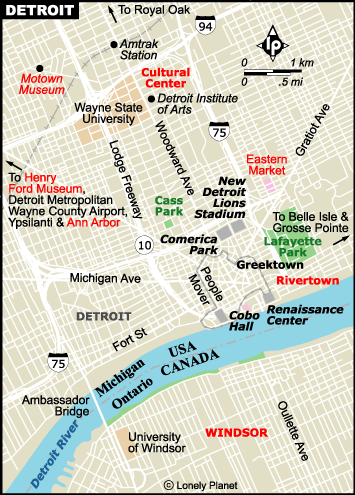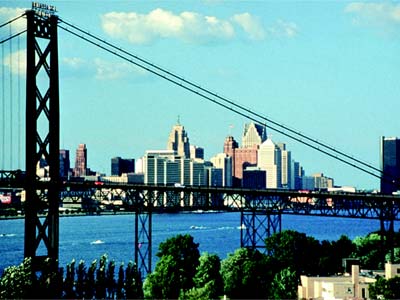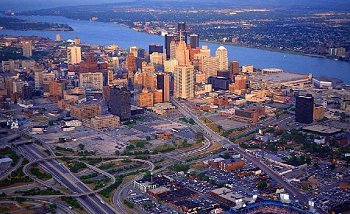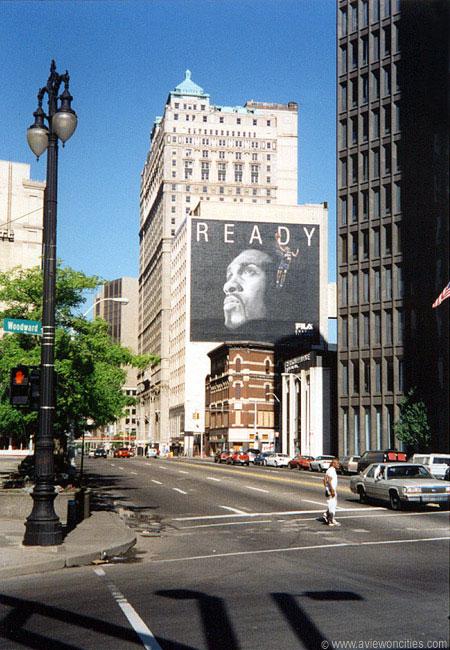|
Where is Detroit?
Detroit is situated in the flat plains of southeast Michigan, located strategically on the Detroit River immediately north
of Windsor, Canada - one of very few places where a Canadian city is south of its US neighbor. Not surprisingly, Detroit serves
as a major gateway to the Great White North. It also holds the distinction of being the largest metro area on any international
border in the world. Detroit is just northwest of Lake Erie and not far from Lake St Clair (the two of which are connected
by the Detroit River). Chicago is 275 miles (440km) west, or five hours by car.

History of Detroit
History
Lots of people know that Cadillacs come from Detroit. But what they probably don't know is that Detroit came from a Cadillac.
Enterprising French trader and explorer Antoine de la Mothe Cadillac stumbled upon what is now Detroit in 1701, figuring it
would make a good base from which to send furs to Canada. Cadillac named his new find Ville d'Etroit (City of the Strait)
because the Detroit River connects Lake St Clair with Lake Erie, and from that point on the town grew steadily, using its
river as an economic channel to the world.
Detroit might have remained little more than a stomping ground for trader types had it not been for an ambitious industrialist
named Henry Ford. Born on a farm in nearby Dearborn, Ford left for Detroit to establish the Ford Motor Company in 1903. Within
five years he was mass producing cars and perfecting the assembly line. The assembly line inspired another Detroit innovation
known as the United Auto Workers (UAW), who kicked off the industrial union movement from the 'Motor City.' Driven by the
automobile's success, Detroit was the first city to have a paved concrete road (in 1909), the first to install a traffic light
(in 1915) and the USA's first to have an urban freeway (in 1942).
Pre-car, Detroit was an important station along the Underground Railroad, a network of escape routes used by abolitionists
and African-American slaves who traveled from America's southern states, through the US north and into Canada. Said to have
been in place as early as the colonial period, the height of Underground Railroad activity was between 1830 and 1865. Detroit
was a major escape route because of its proximity to the Canadian border. The new arrivals brought with them the beginnings
of jazz and blues music. From the late 1800s on, African-American musicians played an important role in Detroit's entertainment
scene, and the city was the first to have an integrated musicians' union. Mississippi transplant John Lee Hooker recorded
his first blues hits here in the 1940s. Hooker and his peers paved the way for Motown - the biggest American music phenomenon
of this century and African-American Detroit's ticket to the big leagues.
But Detroit's prominence on the world music stage didn't prevent the city from imploding. While everyone was dancing in
the streets, businesses - following Ford's earlier lead - started fleeing for the suburbs, and middle-class whites followed
in painful numbers. Detroit lost nearly a million residents between the 1950s and 1980s and, as the auto industry downturned,
hyper unemployment set in, disproportionately affecting African-American men. Along the way, bloody race riots in 1967 and
a cruel recession during the 1970s were just a few of the nails in the coffin.
Today, downtown is quiet, boarded up, desolate in some areas and economically segregated, leaving Detroit with one of the
worst reputations for violence, crime and decay. Not all of Detroit is depressing, though, and currently the local economy
is on an upswing and unemployment is down. The city's rich history, riverfront locale and considerable dedication to rejuvenation
will really take hold of you, if given the chance.
About Detroit
Population: 1 million
Country: USA
Time Zone: GMT/UTC -5 (Eastern Time)
Attractions
Cultural Center
A few miles north of downtown is the Cultural Center, a cluster of world class galleries and museums. The collection of
the Detroit Institute of Arts spans 5000 years, but its pièce de résistance is a Diego Rivera mural called Detroit Industry,
which takes up all four walls of a large interior garden court. Rivera painted the 27 fresco panels in 1932 to depict the
auto industry and contrast the area's natural resources with its factories. Little did he know that times would get tough
for both the industry and its workers a few decades later. The Ford Motor Company's plant at River Rouge (south of Detroit)
served as a model for parts of the mural. The Detroit Historical Museum, a couple of doors away, fills in the blanks of Detroit's
earlier days. Its exhibits include Detroit at work, a chronology of the auto industry and recreated Detroit streets from the
1840s, 1870s and early 1900s.
Detroit was an important station along the Underground Railroad, a rough and tumble network of escape routes used by abolitionists
and African-American slaves who traveled from America's southern states, through the US north and into Canada. The Second
Baptist Church of Detroit was the city's first African-American church and served as a leading 'station' on the Underground
Railroad in the mid-1800s. Today it gives tours of the crawl spaces where the slaves were hidden on their journey. The Museum
of African American History is the world's largest African-American historical and cultural museum with exhibits, classes,
a library and theatre. The museum is in the heart of the Cultural Center, one block from the Institute of Arts and near the
Detroit Science Center, a space dedicated to scientific interaction and featuring an IMAX theatre.
Detroit Zoo
Opened in 1928, the Detroit Zoo was one of the first to have barless animal exhibits, developing a system of moats and
other natural barriers to keep hungry lions, tigers and bears away from grandma and the kids. The Penguin House is the most
fun of all. The zoo's goal is to provide a natural habitat for its animals, who number in the thousands and include over 50
endangered and threatened species, as well as two that are extinct in the wild. Over a million people visit the zoo every
year. The zoo also has a reputation for technological savvy, with state of the art graphical kiosks accompanying many of the
lounging animals.
Eastern Market
Eastern Market is a gigantic semi-covered farmers' market, held every Saturday rain or shine, that sells everything from
goats to olive oil. It attracts farmers and consumers from as far as Florida, plus Martha Stewart devotees in fur coats and
panhandlers singing the blues. There's no better place in Detroit for people watching or picnic packing. The area surrounding
the market is also great for cheap eats. The market lies on the northeast outskirts of downtown.
Motown Museum
A young, black Detroiter, Berry Gordy Jr, started Motown in 1959, naming it after his city's loose way of shortening its
'Motor City' moniker. Confident and cocky, he bought a house in the northern part of Detroit, built a studio and quickly put
a sign on his new company that read 'Hitsville USA.' The sign still sits on the roof. Once the hits - by artists like Smokey
Robinson, Marvin Gaye, the Temptations and the Supremes - really started hitting, Gordy bought six other houses on the block.
The museum features a short video introduction to Motown's history and then you're off for a tour through the original recording
studio, passing through rooms full of photos, album covers, newspaper clippings, gold records and Michael Jackson's black
hat and sequined glove. Though at times a bit kitschy, it's hard not to get wrapped up in the history and good times that
the Motown sound represents.
Rivertown
While walking through much of downtown Detroit can be like touring a not-so-amusing ghost town, the eastern area along
the riverfront is a vibrant and rather attractive section of the city with lots to see and do. Detroit's black circular glass
Renaissance Center (RenCen) is full of offices, hotels, restaurants and shops. From the top, it has a stupendous view of the
Great Lakes, Michigan's prairies and nearby Canada - worth a peruse either from the revolving restaurant or the free viewing
deck.
Walking distance from the glitzy RenCen is Greektown, a packed 8-block hub of Mediterranean life, full of traditional Greek
restaurants, fresh-baked baklava bakeries, bustling coffeehouses and ouzerias. There's also an active Greek orthodox church
that's quite easy on the eyes. Nearby is Trappers Alley, a historic fur trapper's warehouse that now houses shops and a museum.
Some pics of Detroit
The Ambassador Bridge between Windsor, Ontario, Canada and Detroit, Michigan USA

The Detroit Skyline

Panoramic View of Detroit

Downtown Detroit

|

